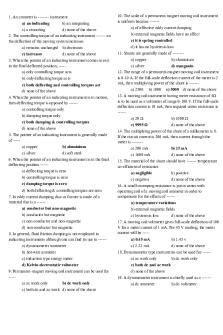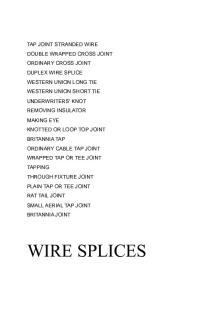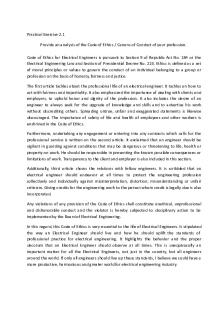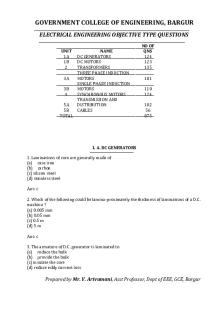E-Notes PDF Basic Electrical Engineering Unit-5 PDF

| Title | E-Notes PDF Basic Electrical Engineering Unit-5 |
|---|---|
| Course | Basic Electrical Engineering |
| Institution | Gujarat Technological University |
| Pages | 24 |
| File Size | 999.2 KB |
| File Type | |
| Total Downloads | 49 |
| Total Views | 141 |
Summary
In this documents, you will get the easy method to solve Basic Electrical Engineering problems with examples. The content of the notes is very easy to understand and really helps to increase your Basic Electrical Engineering proficiency. All the chapters are filtered in a good manner....
Description
5 Electrical Installations 5.1
What is fuse? Define its characteristic. •
Fuse is the simplest device, which break the circuit under abnormal condition.
•
It is only a current interrupting device under fault condition.
•
It is not able to make or brake the circuit under normal condition.
•
A fuse consists of a metal strip of mounted between a pair of electrical terminals, and enclosed by a non-conducting and non-combustible housing.
•
The fuse is arranged in series to carry all the current passing through the protected circuit.
Figure 5.1 Fuse connected in circuit
•
The fuse element is made of zinc, copper, silver, aluminum, or alloys.
•
The fuse element may be surrounded by air or by materials to quench the arc. Silica sand or non-conducting liquids may be used.
•
It is used for overload short circuit protection in medium voltage (up to 33 kv) and low voltage (up to 400v) installation.
•
Fuse characteristics are drawn between current and time scale. The curve shows that fault current and operating time is inversely proportional to each other.
•
The time considered is précising time and current is prospective current.
•
The fuse characteristics become asymptotic and there is a minimum current below which the fuse does not operate. This is called minimum fusing current. FUSE Characteristics Current
Time
Figure 5.2 Fuse Characteristics
Basic Electrical Engineering (3110005)
1
5 Electrical Installations They should have a following desirable characteristic:•
Low melting point
•
High conductivity
•
Free from deterioration from oxidation
•
Low cost
5.2
Write short note on HRC fuse.
Outer Element Filling Powder
Brass end plate
Fuse Element
Fuse Link Contact
Figure 5.3 HRC Fuse
•
When the load capacity is very high the level of fault current will also increase. So faulty clearing device will be under heavy stress.
•
HRC fuse is preferred for heavy duty and rapid operation.
•
It consists of heat resisting ceramic cylindrical body having low co-efficient of thermal expansion.
•
The fuse element is made up of silver or silver alloy to improve fuse life.
•
It is filled with incombustible powder which absorbs the arc produced at the time of blowing.
•
The rating is much more accurate. It is widely used because of silent operation and nondeteriorating characteristics.
•
It is maintenance free and easy to install. Advantages:-
•
Speed of operation is very high.
•
Maintenance cost is practically is zero.
•
They deteriorate with age.
•
They provide reliable operation.
•
They cheaper than other protecting devices. Disadvantages:-
•
Heat produced by arc may affect the associate switches.
•
They have to be replaced after each operation.
Basic Electrical Engineering (3110005)
2
5 Electrical Installations 5.3
Compare Fuse with MCB. o o o o o o
5.4
Fuse Melts the wire when fault occurs Fuse wire available may not be standard rating Operated at 50 to 100 % over load capacity Hand tools are required to rewire the fuse when blown off Cheapest among all safety device Fuse board (mounting arrangement) is not compact
MCB o Cut-off circuit when the fault occurs o MCB available is of standard rating o Operated at 5 to 15 % over load capacity o No hand tool required to reset o Initial cost is very high o MCB board (mounting arrangement) is compact
Compare MCB with ELCB. o
o o o o o o
MCB MCB is an electromechanical device which protects an electrical circuit from an over current and in short circuit condition. MCB has slower operation time than ELCB. The operating principle of MCB is simple. MCB does not give human protection. MCB is cheaper than ELCB. Rated current is not more than 100 Ampere. This circuit breaker connects the phase and neutral terminal.
o Applications: o Domestic and commercial purposes.
ELCB o The ELCB is used to protect the circuit from the electrical leakage.
o ELCB has rapid operation compare to MCB. o The operating principle of ELCB is complicated. o ELCB gives human protection. o ELCB is costlier than MCB. o The range of rated current us up to 1000 Ampere. o This circuit breaker connects the phase, earth wire and neutral terminal. o Applications: o Mostly in Domestic purposes.
Basic Electrical Engineering (3110005)
3
5 Electrical Installations 5.5
Write short notes on MCB.
Figure 5.4 MCB Construction
•
MCB have the features of good HRC fuse and a good switch.
•
These are used for switching purpose under normal condition and circuit break under overloading and short circuit condition.
•
It is normally operated at 1.25 times its rated current.
•
It is manufactured with quick reset hand operated facility.
•
It is basically operated on two type of working principles:
•
❖ Thermal operation: It is achieved by bimetallic strip which deflects when heated by any over current flowing through it.
•
❖ Magnetic operation: When short circuit occurs the rising current energizes the solenoid further operating plunger to strike the trip lever immediately releasing of latch mechanism. Construction of MCB
•
The casing of MCB is made of moulded thermoplastic polyester. This material is fire retardant and non-hygroscopic. They are installed directly on Rail in distribution boards, control panels simply by fixing.
•
The contacts are made of Silver- Copper alloy which ensure longer life of contacts. These have low resistance resulting in low watt loss. The contacts are designed to have zero Bounce during closing operation.
•
Operating Mechanism of MCB has quick make, quick break, and trip-free mechanism. Application:-
•
MCB are used extensively in low voltage domestic, commercial and industrial.
Basic Electrical Engineering (3110005)
4
5 Electrical Installations 5.6
Write short notes on MCCB. Definition •
MCCB is a switching device which is used in LT electrical system. It provides protection against overload & short circuit. Fault sensing arrangements are installed inside MCCBs & shunt release is provided for remote tripping of MCCB.
•
It is available between 100A & 630Acurrent. Working Principle
• •
MCCB provides protection against overload through thermal mechanism. It has bimetallic contacts which expand & contract on temperature changes (same like an automatic iron).
•
Under normal condition these contacts allow normal current to flow but when current exceeds its trip limit, the bimetallic contacts start heating up & expand until the circuit is isolated/tripped.
•
When MCCB is tripped, faulty circuit is isolated from circuit & the temperature of bimetallic contacts starts getting normal & MCCB again is ready for next operation.
•
MCCB provides protection against short circuit – if current is very high, fault current should be interrupted immediately.
•
This is achieved by electromagnetic induction. Whenever fault occurs, the high current induces a magnetic field in a solenoid coil located inside the breaker, this magnetic induction trips a contact & current is interrupted.
•
In the tripping process, arc is produced & that is dissipated by taking suitable measures inside the breaker.
•
These breakers can be manually switched off or on also which is required during maintenance or other purpose.
Figure 5.5 MCCB Basic Electrical Engineering (3110005)
5
5 Electrical Installations
•
Current rating of MCCB A typical range of Three phase MCCB are – 100A, 125A, 150A, 200A, 250A, 315A, 400A, 630A (These ranges are standard rating that available in the market) Application:
•
Especially for industrial purposes where load current are more than 100A.
•
It is used in cement industries, ceramic industries, food processing industries etc.
• •
5.7
List various device used in Electrical Circuit. Write the brief note on ELCB. Followings Protective Device used in Electrical Circuit:(1) Fuse (2) Miniature Circuit Breaker (MCB) (3) Earth Leakage Circuit Breaker (ELCB) (4) Relay ELCB:•
Earth Leakage Circuit Breaker (ELCB). An Earth Leakage Circuit Breaker (ELCB) is a device used to directly detect currents leaking to earth from an installation and cut the power and mainly used in TT earthing systems.
•
For the protection of human body from the electric shock protective device like fuse or MCB are used.
•
But generally this device are incapable of measuring small current flowing in human body, so requirement is to have a device which can sense small current and cut-off the supply instantly.
•
The device used for this purpose is known as Earth Leakage Circuit Breaker (ELCB). There are two types of ELCBs:
•
1. Voltage Earth Leakage Circuit Breaker (Voltage-ELCB)
•
2. Current Earth Leakage Current Earth Leakage Circuit Breaker (Current-ELCB). Circuit Diagram:-
Test push button Test Resistor Circuit Breaker
L
Load
Trip Coil
Load casing and frame are earthed
N
Figure 5.6 ELCB Circuit Diagram Basic Electrical Engineering (3110005)
6
5 Electrical Installations Working of ELCB •
It is current operated device designed to operate when a leakage current exceeds the predefined value.
•
It consists of a operating coil and a trip mechanism which operated the circuit when required.
•
The coil is supplied through 1-Ф supply so current in phase & neutral wire will be same.
•
This current will produce flux linkages same in magnitude but of opposite direction. This will result zero net flux in tripping coil of relay.
•
When fault or leakage current exceeds the limit higher current will flow in phase conductor than neutral current.
•
Resultant flux now is out of balance in tripping coil of relay. Difference of flux will induce emf in the coil which opens the contact of ELCB and isolate the circuit from the supply.
5.8
Explain types of wire •
There are different types of wire are listed below:
•
Triplex wire: Triplex wires are usually used in single-phase service drop conductors, between the power pole and weather heads. They are composed of two insulated aluminum wires wrapped with a third bare wire which is used as a common neutral.
•
Non-metallic sheathed wires: Non-metallic sheath wire is used in most homes and has 2-3 conductors, each with plastic insulation, and a bare ground wire. The individual wires are covered with another layer of non-metallic sheathing. Since it’s relatively cheaper and available in ratings for 15, 20 and 25 amps, this type is preferred for in-house wiring.
Triplex wire
Non-metallic sheathed wire
Single strand wire
Figure 5.7 Types of wire
•
Single Strand Wire: Single strand wire also uses THHN (Thermoplastic High Heatresistant Nylon-coated) wire, though there are other variants. Each wire is separate and multiple wires can be drawn together through a pipe easily. Single strand wires are the most popular choice for layouts that use pipes to contain wires.
Basic Electrical Engineering (3110005)
7
5 Electrical Installations 5.9
Explain types of Cable
• • • •
•
Under ground cable are classified as follow: (1) According to voltage level: Low voltage (L.T.) cable: It consist of one circular core of tinned stranded copper (or aluminum) insulated by layers of impregnated paper. These cable are used up to 1 kV. High voltage (H.T.) cable: It consist of either circular shaped or oval or sector shaped 3 core stranded copper or aluminum. These cable are used up to 11 kV. Super tension (S.T.) cable: The insulation on each core is covered with aluminum foil or own lead sheath or metallized paper. These cable are used up to 33 kV. Extra high tension (E.H.T.) cable: oil filled cable and gas pressure cable are types of E.H.T. cable. Oil filled cable is consist of oil channel at the center of core by stranding the conductors wire around the hollow cylindrical steel spiral tape.Gas pressure cable is laid in a gas tight steel pipe which is filled with dry nitrogen at 12 to 15 atmosphere pressure produces radial compression and closes the voids. These cable are used up to 66 kV. Extra super voltage cable: These cable are used up to 132 kV and above. (2) According to insulating material :
•
•
•
•
•
•
Insulation is provided on conducting material to block the path of leakage current from the conductor,thus minimizing the risk shock and fire. Normally cables are classified according to the insulation used over the conductor. The various classification of cable commonaly used for domestic wiring are as follow: Vulcanized rubber sheathed (V.I.R.) insulated cables: These consists of a copper conductor covered with a insulation layer of Vulcanized Indian Rubber (VIR). A cotton tape covering is provided over this insulation layer to protect the wire from moisture and to provide mechanical strength to the wire. The thickness of the Vulcanized Indian Rubber depends on the voltage. Cab Type sheathed (T.R.S.) cables: These C.T.S or T.R.S wires consists of vulcanized rubber insulated conductor. This insulation layer is covered by a layer made of tough rubber (or) tough rubber sheathed covering is provided over this insulation layer. This covering will be very hard and protects the wire from moisture and provides mechanical strength to the wire. These wires are available in single core, twin core, triple core etc. As these wires have tough rubber covering no additional protection or strength is required. Weather –proof cables: These wires consists of conductor provided with an insulation layer made up of hard rubber. Over this cotton sheathed and cotton tape covering is provided especially to protect the wire from moisture. These wires are used where the moisture is present. Polyvinyl chloride (P.V.C.) insulated cables: These wires consists of a conductor over which an insulation layer made up of Polyvinyl Chloride is provided. These wires cannot resist much heat and they have relatively low melting points, so they aren’t used in hot places and also these wires are not used with heating appliances. PVC wires are available in almost all colors. Lead sheathed cables: These wires consists of vulcanized Indian rubber insulated conductor over which a Lead sheath is provided which gives mechanical strength to the Basic Electrical Engineering (3110005)
8
5 Electrical Installations
• • o o o
o 5.10 • •
•
•
wire and it also protects the wire from moisture. These wires are generally used where there is chances of moisture like in snowy places. As Lead is a good conductor of electricity the Lead covering may give electric shock to us so to prevent this the Lead covering is provided with earth wire. These wires are available in single core, twin core, triple core etc size. (3) According to number of conductor : Single core: Single core cable means,it consists of one conductor only. Multi core: Multi core cable has more than one core. 2 core cable: In 2 core cable, one conductor act as a phase and another act as a neutral. Both conductor have a equal cross sectional area. 3 core cable: In 3 core cable, all the conductors have a equal cross sectional area. Three strand carry R,Y and B phases respectively. 3 ½ core cable: In 3 ½ core cable, 3 conductors have a equal cross sectional area. Three strand carry R,Y and B phases respectively. Fourth core having cross sectional are half than that the other. Fourth core are used as a neutral. 4 core cable: In 4 core cable, all the conductors have a equal cross sectional area. All strand carry R,Y ,B phases and neutral respectively. Cable construction with neat sketch diagram Construction of cable as shown in figure. Different parts of cable are given below. Conductor: Conductors used for cables are generally made up of tinned copper or aluminium.To provides the sufficient flexibility conductors are used in stranded form. Cable may consist of one, two, three of four conductors depending upon the service required. Paper insulation: The type and thickness of insulation depends upon the voltage level. Insulating materials should provide the following properties: High insulation resistance, High mechanical strength, Non-porous, Chemically inert, high die-electric strength, Noninflammable etc. Following are the different materials used for cable insulation: Rubber, Vulcanized India Rubber, Impregnated paper, PVC etc. Lead sheath
Armouring
Conductor
Paper insulation
Bedding
Serving
Figure 5.8 Construction of cable Basic Electrical Engineering (3110005)
9
5 Electrical Installations •
• • • 5.11
Lead Sheath: As the cable is placed under ground, soil may present moisture, gases and some other liquids. Therefore, to protect the cable metallic sheath made up of lead or aluminum is provided over the insulation. Bedding: To protect the metallic sheath from corrosion and some mechanical injury, bedding is provided. It is made up of some fibrous material such as jute. Armoring: Armoring is used to protect the cable from mechanical injury while handling. It consists of one or two layers of galvanized steel wire or steel tape. Serving: Serving is provided to protect the armoring from atmospheric conditions. It is made up of some fibrous material like jute. Eatrhing System
❖ What is Eatrhing? Explain the purpose of Earthing. OR Grounding. • “The earthing is the connection of general mass of earth to electrical apparatus in such a manner as to ensure all time an immediate energy discharge without danger”. • The earth is made up of a material that is electrically conductive. A fault current will flow to earth through the live conductor, provided it is earthed. • The Conventional system of Earthing is done by digging of a large pit into which a GI pipe or a Copper plate is positioned with the layers of charcoal and salt. • When system is without earthing and if short circuit occurs and human body touches the metal part, current will get return path through human body. • When system is properly earthed and if short circuit occurs and human body touches ...
Similar Free PDFs
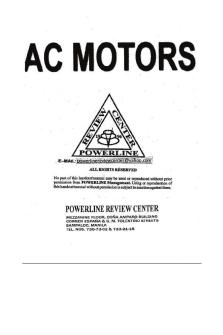
AC Motors101 Electrical Engineering
- 17 Pages

Basic Electrical Notes answers
- 3 Pages

Electrical engineering - Wikipedia
- 18 Pages

MPO - enotes
- 2 Pages
Popular Institutions
- Tinajero National High School - Annex
- Politeknik Caltex Riau
- Yokohama City University
- SGT University
- University of Al-Qadisiyah
- Divine Word College of Vigan
- Techniek College Rotterdam
- Universidade de Santiago
- Universiti Teknologi MARA Cawangan Johor Kampus Pasir Gudang
- Poltekkes Kemenkes Yogyakarta
- Baguio City National High School
- Colegio san marcos
- preparatoria uno
- Centro de Bachillerato Tecnológico Industrial y de Servicios No. 107
- Dalian Maritime University
- Quang Trung Secondary School
- Colegio Tecnológico en Informática
- Corporación Regional de Educación Superior
- Grupo CEDVA
- Dar Al Uloom University
- Centro de Estudios Preuniversitarios de la Universidad Nacional de Ingeniería
- 上智大学
- Aakash International School, Nuna Majara
- San Felipe Neri Catholic School
- Kang Chiao International School - New Taipei City
- Misamis Occidental National High School
- Institución Educativa Escuela Normal Juan Ladrilleros
- Kolehiyo ng Pantukan
- Batanes State College
- Instituto Continental
- Sekolah Menengah Kejuruan Kesehatan Kaltara (Tarakan)
- Colegio de La Inmaculada Concepcion - Cebu







